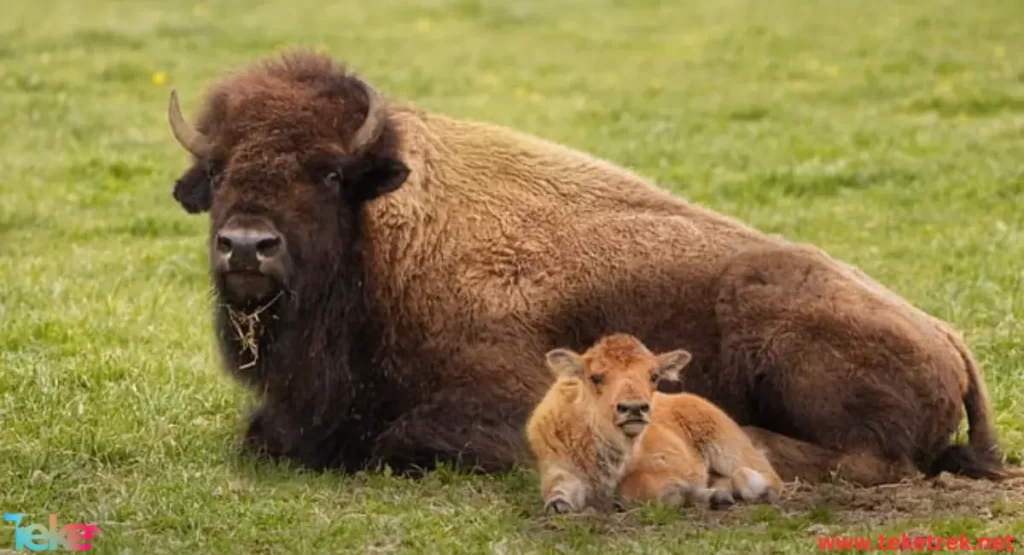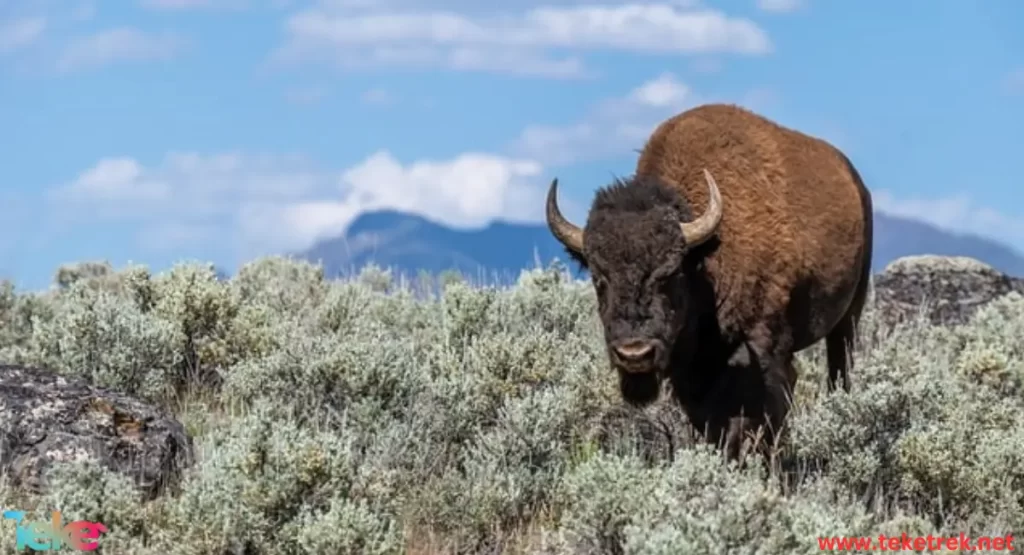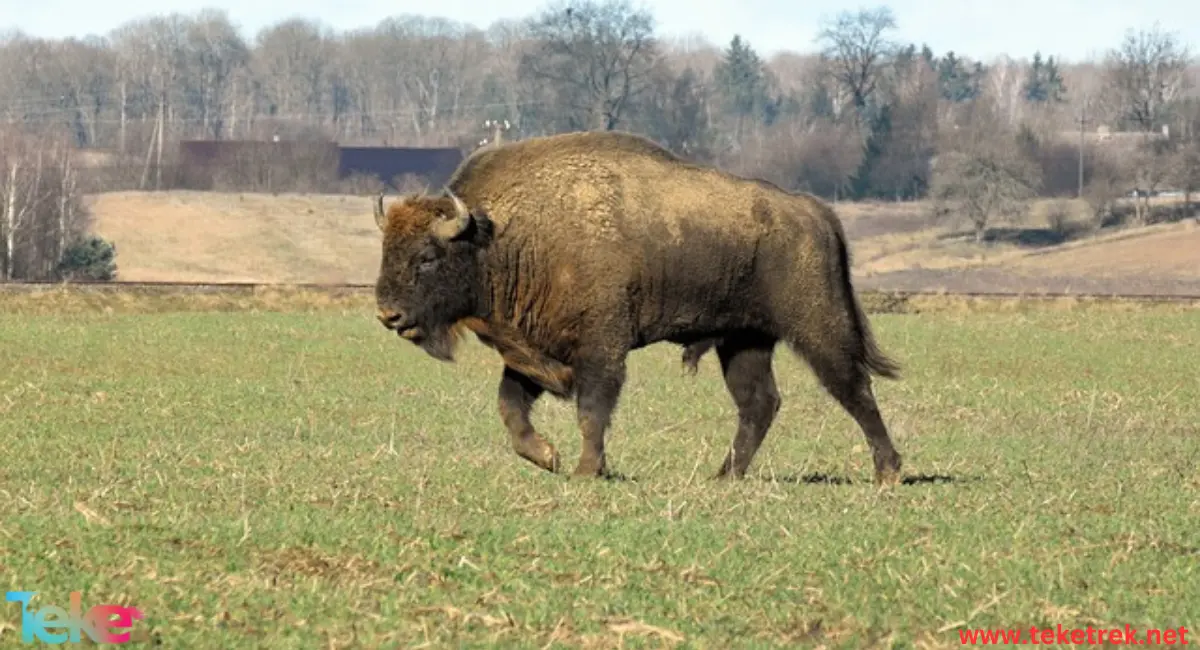The bison is a massive mammal belonging to the Bovidae family. It is also known as the buffalo in North America. The bison is characterized by its huge body, large head with curved horns, and dense fur, which can range from brown to black. It is considered the largest wild animal, with males being larger than females.
Bison used to inhabit vast environments across North America but witnessed a significant decline in numbers due to overhunting and loss of natural habitat. However, some herds have been reintroduced in modern times through wildlife conservation efforts.
Bison are incredibly powerful animals with unpredictable behavior, and if they sense danger, they will attack their opponent without hesitation.
In this article in TekeTrek Website, we will introduce you to the most important information related to this object. Follow along with us.
Description of Bison
- The length of a bison ranges from 2.1 to 3.5 meters.
- The weight of a bison ranges from 422 to 998 kilograms, making it one of the largest wild mammals in North America.
- The bison’s fur is thick and strong, dark brown on the back and sides and lighter on the belly.
- This fur consists of two layers, an inner layer that completely adheres to the skin, trapping warm air adjacent to the skin. And an outer layer that prevents water and cold winds from reaching the skin.
- The bison has a short tail compared to its large body size.
- The male bison is characterized by curved black horns that grow on the skull up to the shoulders, while females do not have horns.
- The bison’s face is short and broad with large eyes and a swollen nose, giving it a strong and distinctive appearance.
- The bison’s ears are small compared to the size of its massive head, which helps prevent dust and insects from entering during movement in dry environments.
- Its legs are covered with thick and dense fur, and it has a long beard hanging from its chin and horns.
- The bison’s neck and head have strong and sturdy muscles, using its head to push other bulls to win females during the mating season.
- It has 14 to 15 pairs of ribs and 4 to 5 lumbar vertebrae.
Bison habitat Where do bison live?
In the past, bison were widely spread throughout North America. Some species inhabit Canada alone. Some live in Mexico and extend to the Atlantic Ocean. Bison are now found in Poland, Belarus, and Ukraine.


bison species
- There are two species of bison that currently inhabit this planet:
- American Bison
- European Bison
- They are very similar in appearance, but the European bison is slightly lighter in weight than the American bison. The American bison has shorter hair on the head and neck, while its tail and horns are longer compared to the European bison.
- The horns of the European species are directed upwards along the head, so they point forward when the bison lowers its head, making them well-suited for combat and locking horns, unlike the American bison, which prefers head-butting in fights.
- The American bison is more easily domesticated than its European counterparts and readily interbreeds with local cattle.
Bison diet
- Bison are considered herbivores, primarily feeding on wild grasses. Their diet consists of a variety of fresh and dry plants available in their natural environment. During winter, they use their heads to move snow and access food. Their diet includes grass, wild plants, herbs, leaves, fruits, roots, and shrubs.
- A bison can consume around 25-50 pounds (11-23 kg) of grass per day, depending on the environment, season, and food availability. In addition to grass, bison may also consume some leaves, fruits, and roots when available.
Reproduction in bison
- The mating season for bison typically occurs in late summer, especially in August and September.
- Bison are polygynous, meaning males mate with multiple females.
- After mating, males guard the females for a certain period to prevent other males from mating with them.
- Gestation in bison lasts between 9 and 9.5 months, and females usually give birth to a single calf in spring or early summer.
- Females care for their calves diligently, providing care and nourishment. Around two months old, their horns start to grow, and they are weaned at around seven months old, becoming independent.
- Growth: Calves start moving with the herd a few weeks after birth and remain with their mother for a period ranging from one to two years.
10 facts about the bison
- Bison have poor eyesight, but their sense of hearing and smell are excellent.
- Due to their strong sense of smell, they can detect another animal through scent from a distance of 3 kilometers.
- Bison have poor eyesight and do not see well.
- Despite their massive size, bison can run at high speeds, reaching up to 55 kilometers per hour.
- They often take mud and dust baths in both wet and dry weather, helping them get rid of parasites from their skin.
- Bison are heavily hunted for their meat and hides.
- Despite being intimidating to most animals due to their large size, they are preyed upon by predators like wolves, mountain lions, and others.
- The average lifespan of a bison ranges from 15 to 20 years.
- When a bison’s tail is held upright, it indicates anger.
- Bison are described as having dull cognitive abilities, with scientists considering them among the dumbest mammals in North America.


FAQ
- Are bison endangered?
The bison species has always been threatened with extinction throughout history. The European and American bison were one of the most abundant animals in North America and Europe, but today there are almost no individuals living in the wild. In fact, the European bison is still almost threatened at the present time and its numbers are declining rapidly.
- How much does a bison weigh?
Bison weight in kg can typically range from 300 to 920 kg.
- Is bison halal in Islam?
Hence, in our opinion, bison meat is halal to be eaten. Especially, when bison isn’t categorized as a predator that hunts their prey for food such as lions, beavers and others. However, bison is a herbivore to only eats grass, shrubs and other similar plants.
At the end of our article, we must emphasize the importance of the bison in the ecosystem. It plays a significant role in environmental conservation by grazing on various grasses and plants, thus contributing to habitat maintenance and ecosystem balance. Additionally, bison help in cleaning the environment by their grazing habits.






